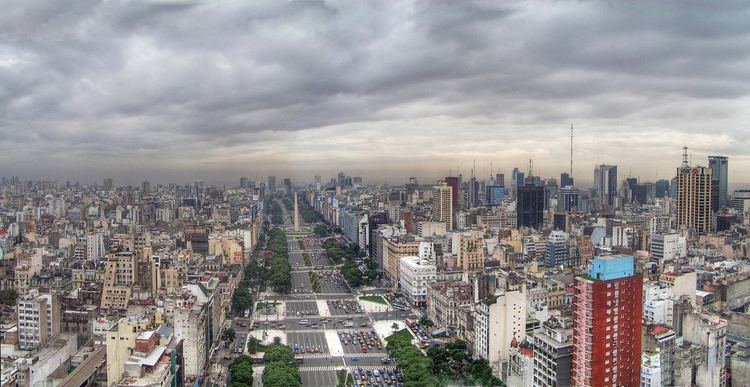Major cities Buenos Aires | ||
 | ||
Similar Obelisco de Buenos Aires, Plaza de Mayo, Teatro Colón - Buenos A, Casa Rosada, La Boca - Buenos Aires | ||
Buenos aires argentina obelisco 9 de julio avenue
July 9 Avenue, located in the city of Buenos Aires, Argentina, is the widest avenue in the world. Its name honors Argentina's Independence Day, July 9, 1816.
Contents
- Buenos aires argentina obelisco 9 de julio avenue
- Map of Av 9 de Julio Cdad AutC3B3noma de Buenos Aires Argentina
- History and overview
- MetroBus Line
- Points of interest
- References
Map of Av. 9 de Julio, Cdad. Aut%C3%B3noma de Buenos Aires, Argentina
The avenue runs roughly 1 kilometre (0.62 mi) to the west of the Río de la Plata waterfront, from the Retiro district in the north to Constitución station in the south. The avenue has up to seven lanes in each direction and is flanked on either side by parallel streets of two lanes each. Through the centre of the avenue runs one of the city's Metrobus (Buenos Aires) (Bus rapid transit) corridors, which stretches 3 kilometres (1.9 mi) and was inaugurated in July 2013. There are two wide medians between the side streets and the main road.
The northern end of the avenue is connected to the Arturo Illia expressway (which connects to Jorge Newbery airport and the Pan-American highway) and to Libertador avenue. The southern end is connected to the 25 de Mayo tollway (serving the west side of Greater Buenos Aires as well as Ezeiza airport) and the 9 de Julio elevated expressway which provides access to the two main southbound roads out of the city (route 1 to La Plata and route 2 to Mar del Plata). The Republic Square is located on the intersection of this Avenue with the Corrientes Avenue and on that point is sited the Obelisk of Buenos Aires.
History and overview
The avenue's unusual width is because it spans an entire city block, the distance between two streets in the checkerboard pattern used in Buenos Aires. The distance between adjacent streets is roughly 110 m, greater than the distance between streets in Manhattan. The street flanking 9 de Julio to the east is called Carlos Pellegrini (north of Rivadavia) and Bernardo de Irigoyen (south of Rivadavia). The street flanking 9 de Julio to the west is called Cerrito (north of Rivadavia) and Lima (south of Rivadavia).
The avenue was first planned in 1888, with the name of Ayohuma; but the road was long opposed by affected landlords and residents, so work did not start until 1935. The initial phase was inaugurated on 9 July 1937 and the main stretch of the avenue was completed in the 1960s. The southern connections were completed after 1980, when the downtown portion of the tollway system was completed. Clearing the right-of-way for these intersections required massive condemnations in the Constitución area.
Line C of the Buenos Aires Metro runs for a stretch under the avenue. Line A, Line B, Line D, and Line E have stations when their course intersects the avenue. Notably, lines B, C, and D share a station underneath the Obelisk, which is the focal point of the subway system and features a retail concourse which also serves as an underpass. The respective station names are Carlos Pellegrini, Diagonal Norte, and 9 de Julio.
Crossing the avenue at street level often requires a few minutes, as all intersections have traffic lights. Under normal walking speed, it takes pedestrians normally two to three green lights to cross it. Some urban planners have submitted projects to move the central part of the avenue underground to alleviate the perceived "chasm" between the two sides of the avenue.
MetroBus Line
The Metrobus 9 de Julio is 3 kilometres (1.9 mi) long with 13 stations and runs down the avenue, taking roughly the same route as Line C of the Buenos Aires Underground. It serves 11 bus lines and reduces bus travel time by 50% along the avenue.[12] The main objective of this line is to join together the city's two busiest railway stations: Retiro and Constitución and to serve the approximately 250,000 passengers per day which use buses along the avenue, with a journey time of 15 minutes instead of the 30 minutes a bus took before the line was built
Points of interest
The main landmarks along the avenue are, north to south:
